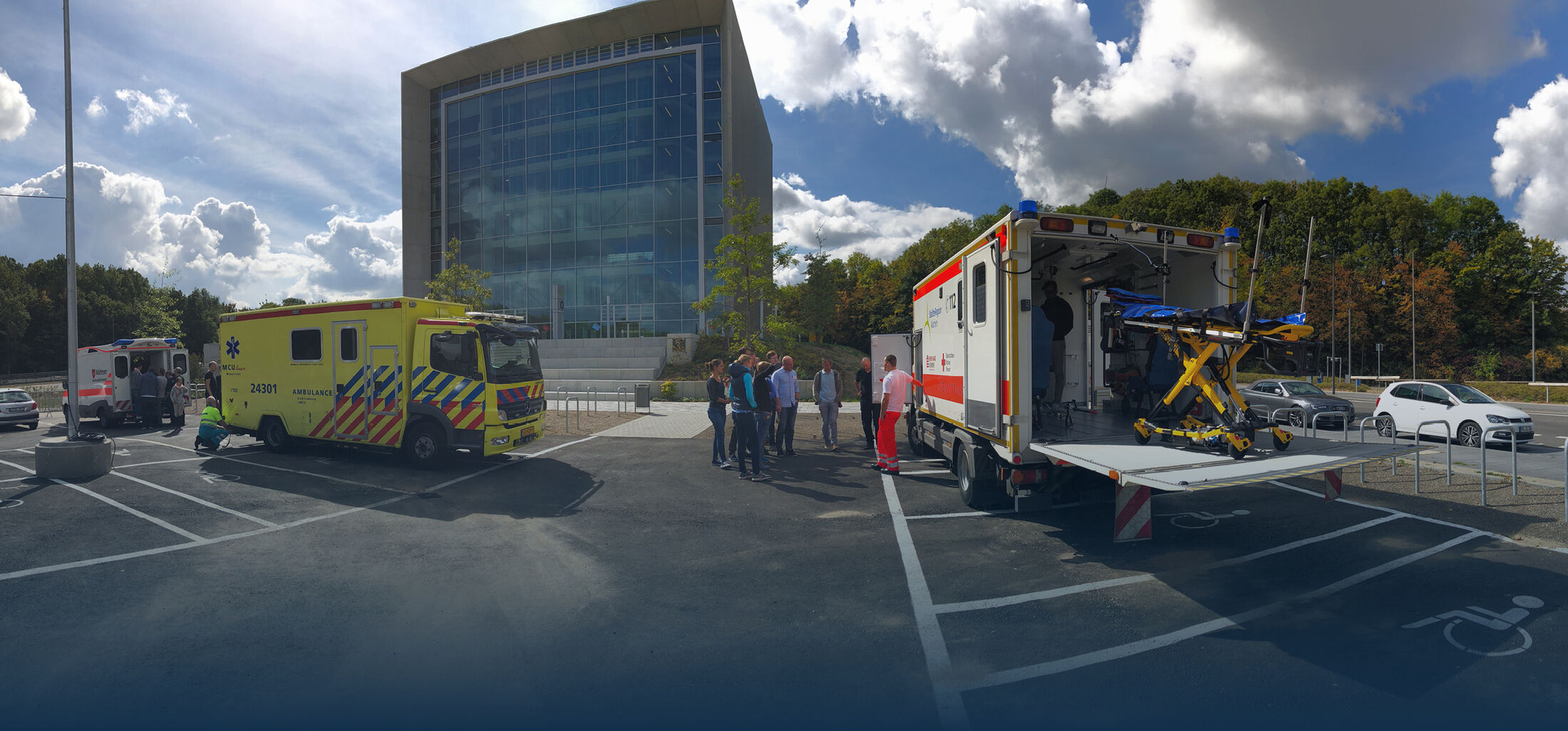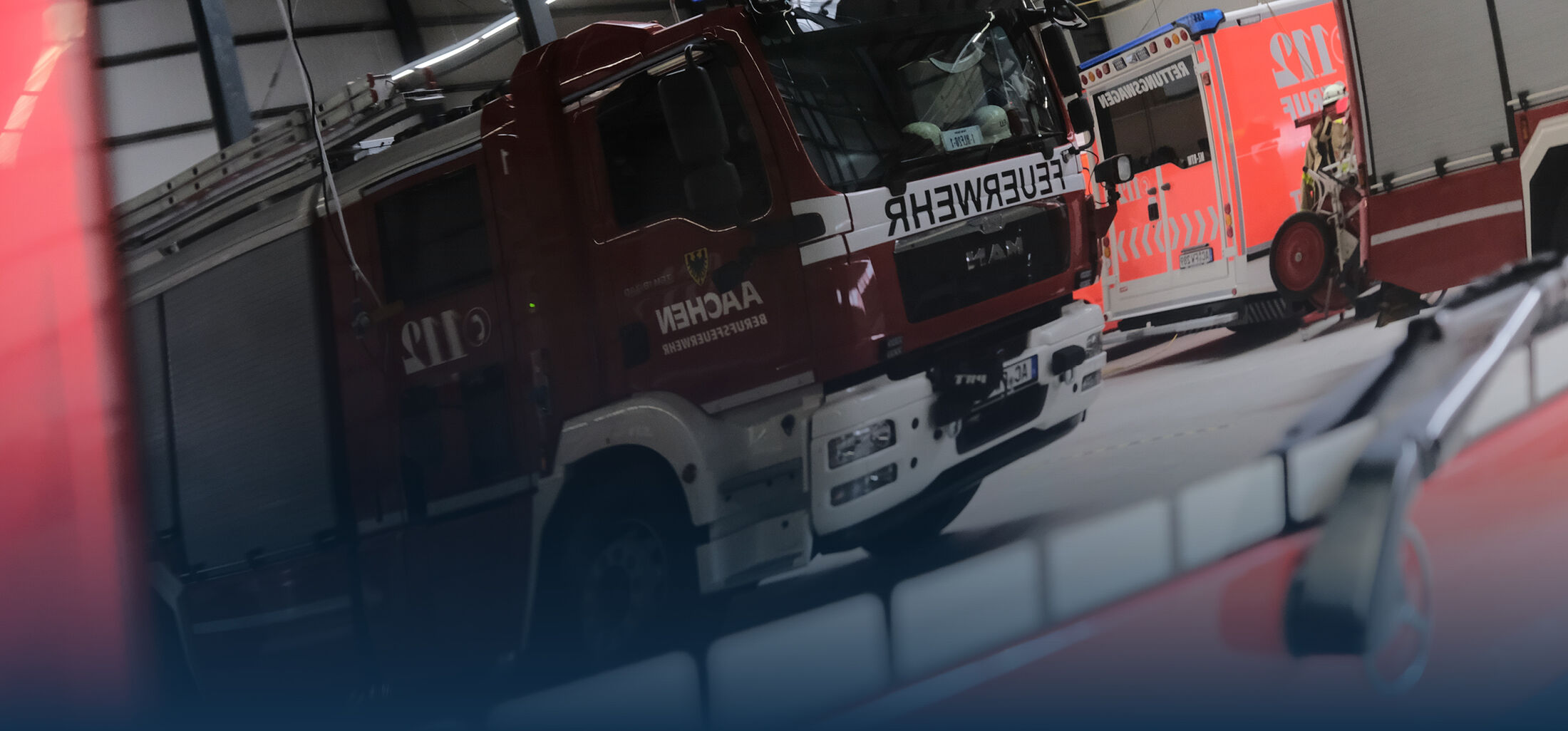
Tele-EMS in Aachen
Based on the two successfully completed Aachen research projects "Med-on-@ix" (2007-2010) and "TemRas" (Telemedical Emergency Assistance Service System, 2010-2013), the tele-EMS system was implemented in 2014 in the regular ambulance service of the City of Aachen. This system is Europe's first comprehensive tele emergency medical service in pre-hospital care. The expertise of the tele-EMS physician is immediately available on the scene, as it’s not necessary for the tele-EMS physician to drive to the emergency location.
The tele-EMS system enables an immediate, safe and reliable teleconsultation of an emergency physician in rescue operations. The live transmission of vital parameters, speech and image material from the scene of the emergency allows the tele-EMS physician to get an exact picture of the patient's condition in order to support the rescue team on site with medical advice, assistance in diagnosis, and the legally compliant delegation of therapeutic measures.
In this way, the period of time until the arrival of a "conventional" emergency doctor can be bridged and the remaining emergency doctor capacities can be used in a more targeted manner.
All legal procedures and processes have been approved by experts within former research projects. In addition, all procedures and processes related to data storage and data security have been coordinated with the data protection officer of the City of Aachen.
The tele-EMS system service is anchored in the emergency medical service demand plan of the City of Aachen and is thus an integral part of the public service as a supplement to the nationwide ground-based emergency doctor service.
The workstation of the Tele-EMS System is located at the main fire station at Stolberger Strasse 155, which is linked to the dispatch centre of the City of Aachen and the surrounding area.
Primary tasks of the tele-EMS system depending on emergency scenario
Emergency response without emergency physician
- After taking the patient’s medical history and after first aid, the ambulance team contacts the Tele-EMS physician if necessary. The tele-EMS physician is contacted for consultation and/or approval of a defined standard therapy in accordance with procedural instructions.This includes the appropriate administration of medication. If the ambulance team and the tele-EMS physician jointly reach the decision that an emergency doctor is required on site, this will be requested immediately.
Emergency response with emergency physician (before emergency doctor is on site)
- If the arrival of the emergency doctor on site is delayed (e.g. due to different travel routes, or if the emergency physician is temporarily unavailable), the ambulance team contacts the tele-EMS physician. This is done after taking the patient’s medical history and initial treatment is completed.
- Before the emergency physician arrives on site, the Tele-EMS physician can provide consultation and/or approval of a defined standard therapy according to procedural instructions. This includes an appropriate administration of medication, hence ensuring early treatment also in life-threatening situations.
Emergency response with emergency physician (support of the emergency physician on site)
- The emergency physician on site contacts the tele-EMS physician after taking the patient's medical history and introducin initial treatment. In this case, the tele-EMS physician can support and advise the emergency physician on-site on various issues (e.g. contacting the emergency poison centre, complex ECG diagnostics, therapy decisions, differential diagnoses, decision on the choice of the target hospital / specialist department, contact with the most appropriate destination hospital, activation of the ECMO (Extra-Corporal Membrane Oxygenation (Heart-Lung-Machine)) team of the university hospital) etc.
Secondary tasks of the tele-EMS physician
Advice to the dispatch centre
- Advice and support for dispatch centre staff on medical issues of the rescue service in their daily operations.
Medical coordination of secondary transports
- The tele-EMS physician takes over the medical coordination of secondary transports. All registered secondary transports that contain a request to an accompanying emergency doctor are screened by the tele-EMS physician. A physician-to-physician consultation takes place between the tele-EMS physician and the attending physician of the delivering hospital for standardised recording of the patient's condition and the transport requirements.
- The tele-EMS physician decides which means of transport is required for secondary transport. In addition to standard ambulance transfers and emergency-doctor-assisted intensive care transfers, patients who meet the criteria for tele-EMS physician accompaniment can be transported by an ambulance with additional monitoring by a tele-EMS physician. This way, pain therapy or other medication required during the transport can be administered.
Umlaut telehealthcare GmbH (formerly P3 Telehealthcare GmbH) was commissioned as the operator to carry out the integration of the tele-EMS system as specified in the emergency service requirement plan for the city of Aachen.
Most of the tele-EMS system physicians come from the University Hospital RWTH Aachen, but they all meet the locally defined standards listed below. Physicians from other hospitals in the region are also able to participate in the tele-EMS ambulance service.
Qualification profile of tele-EMS physicians
In order to meet the special quality requirements for tele-medically supported emergency operations, only particularly experienced emergency doctors who meet the following requirements are employed as tele-EMS physicians:
- Specialist in anaesthesiology or specialist standard (at least 5th year of further training)
- Extensive experience in emergency medical services (over 500 missions on-scene)
- Additional certification in emergency medicine of a medical association
- Proof of a certified standard of care in resuscitation care (Advanced Life Support (ALS) provider course, e.g. of the ERC)
- Proof of a certified standard of care in trauma care (e.g. Pre-Hospital Trauma Life Support (PHTLS) Provider Course)
Structured familiarisation concept and tele-EMS physician manual
All tele-EMS physicians are specifically prepared for their work by a structured induction concept including a tailored tele-EMS handbook. Furthermore, all tele-EMS physicians are instructed to technical, organisational and medical details of the system. The focus is on the structured use of evidence-based procedural instructions, which are made available to the tele-EMS physician in a context-sensitive manner via a special software.
Supervision
Regular direct supervision and debriefings are a decisive pillar of the quality management of the tele-EMS system service, together with regular training. In addition to technical aspects, the focus is also on communication between the ambulance team and the tele-EMS physician.
Regular advanced training courses
The tele-EMS physicians regularly participate in advanced training for therapies according to the latest guidelines and recommendations.
Medical management of tele-EMS system
The organisational supervision of the tele-EMS physician group is incumbent to the City of Aachen. It belongs to its duties by being the responsible body for rescue services in general. The tele-EMS system is implemented by the Rescue Service Department in cooperation with the Medical Management of the Rescue Service.
As Medical Director of the tele-EMS Service, Dr. Marc Felzen, MD coordinates the group of tele-EMS physicians and is responsible for all organisational matters. Together with Dr. Stefan Beckers, the professional and medical supervision is carried out by the Medical Director of the EMS system. The two medical directors determine appropriate standards for consultation and treatment and review its compliance.
Context-sensitive procedure instructions integrated into the software
All procedural instructions of the participating regions (City of Aachen, Euskirchen District, Heinsberg District, Main-Kinzig District, Korbach) can be retrieved in the user interface of the tele-EMS system. In addition to the display of a flow chart specially adapted to the general conditions of the teleconsultation, additional information is provided to the tele-EMS physician. For each procedure instruction there is a checklist-based documentation interface, which i.a. reduces documentation effort. The greatest benefit of this interface is the graphical depiction of whether all points for guideline-based emergency care have been met yet. Thus, guideline-compliant therapy is possible even in more complex situations. The contents of the procedure instructions are strictly evidence-based and represent the current state of knowledge of guidelines and research.
Quality circle rescue service / hospital
The services provided by the tele-EMS physicians are also discussed and evaluated in the quality management circles with the hospitals and emergency medical service organisations. Any need for improvement can thus be identified and solutions can be implemented.






